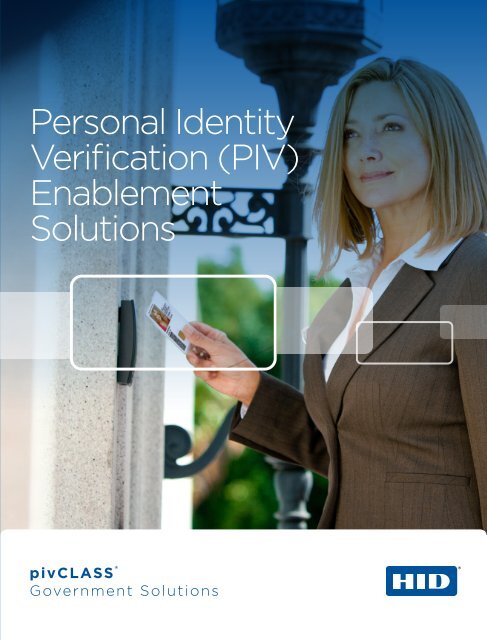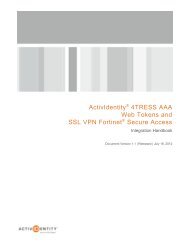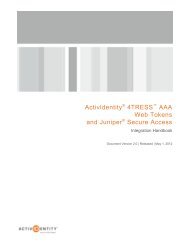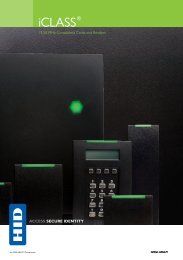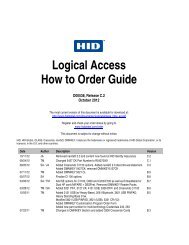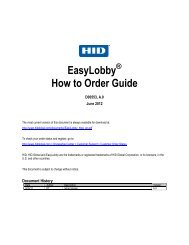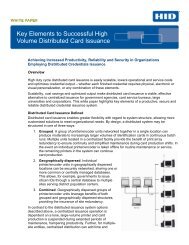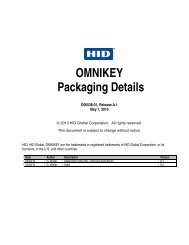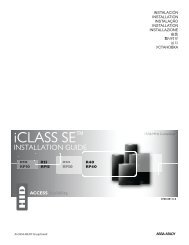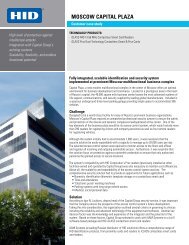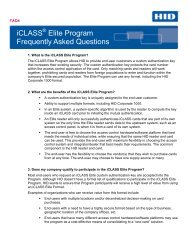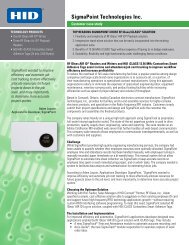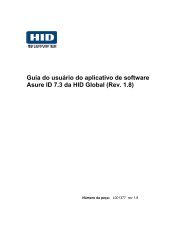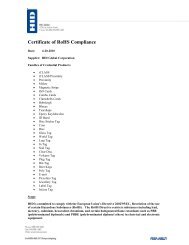pivCLASS Solutions Brochure - HID Global
pivCLASS Solutions Brochure - HID Global
pivCLASS Solutions Brochure - HID Global
Create successful ePaper yourself
Turn your PDF publications into a flip-book with our unique Google optimized e-Paper software.
Personal Identity<br />
Verification (PIV)<br />
Enablement<br />
<strong>Solutions</strong><br />
<strong>pivCLASS</strong> ®<br />
Government <strong>Solutions</strong>
Affordable Personal Identity<br />
Verification (PIV) Enablement<br />
<strong>Solutions</strong> from a Single,<br />
Trusted Supplier<br />
Complete Solution for PIV Enablement<br />
<strong>HID</strong> <strong>Global</strong>’s <strong>pivCLASS</strong> ® Government <strong>Solutions</strong><br />
portfolio is an extensive product family that<br />
makes it easy for U.S. Federal Government,<br />
government contractors and other facilities to<br />
comply with security regulations and to use<br />
their Personal Identity Verification (PIV) and<br />
other smart cards for physical access control,<br />
resulting in compliance, interoperability and<br />
high security.<br />
FIPS 201 Compliance Without The Need to<br />
“Rip and Replace”<br />
The <strong>pivCLASS</strong> modular approach provides<br />
government agencies the ability to use<br />
their PIV identity cards for strong public<br />
key infrastructure (PKI)-based validation for<br />
physical access control. The solution enables<br />
this functionality without the need to “rip<br />
and replace” existing physical access control<br />
systems (PACS), reducing costs, and removing<br />
complexities to make it easy and affordable to<br />
acquire, install and maintain compliant physical<br />
access control systems.<br />
<strong>pivCLASS</strong> accomplishes this in part by<br />
communicating with an agency’s PACS<br />
and external trust authority PKIs to deliver<br />
functionality specified by National Institute<br />
of Standards and Technology (NIST) Federal<br />
Information Processing Standards Publication<br />
201 (FIPS 201).<br />
An Integrated Solution from a Single Provider<br />
Delivering fully tested and validated<br />
turnkey government solutions from a single,<br />
trusted source, <strong>pivCLASS</strong> authenticates PIV<br />
credentials across the full range of assurance<br />
levels as defined by the federal government’s<br />
Special Publication 800-116 (SP 800-<br />
116). <strong>pivCLASS</strong> products also support the<br />
Transportation Worker Identification Credential<br />
(TWIC) Reader Specification.<br />
The <strong>pivCLASS</strong> portfolio includes <strong>pivCLASS</strong><br />
Authentication Module (PAM), <strong>pivCLASS</strong><br />
Validation Server and a complete line of<br />
<strong>pivCLASS</strong> readers, enabling agencies to<br />
quickly and easily acquire all of the necessary<br />
components for their PIV-enabled access<br />
control systems.
Achieving Compliance Made Simple<br />
How it Works<br />
Working together to deliver strong<br />
authentication at the door and during the<br />
initial cardholder registration, the <strong>pivCLASS</strong><br />
solution ensures the cardholder is the person<br />
he/she claims to be and verifies the card<br />
has not been forged, altered, cloned, lost,<br />
stolen, shared, revoked or expired. <strong>pivCLASS</strong><br />
accomplishes this by performing the following<br />
functions:<br />
Executes full path discovery and<br />
certificate revocation checking using CRL,<br />
OCSP or SCVP.<br />
Periodically retrieves card revocation<br />
status from issuing certificate authorities.<br />
Caches validation data and offers<br />
degraded mode settings to allow<br />
continued validation when access to<br />
card issuer validation data (e.g., CRL) is<br />
unavailable.<br />
Validates cardholder credentials both at<br />
the door and during a card’s registration<br />
into local access control software.<br />
Validates cardholder credentials visiting<br />
from other agencies (i.e., provides<br />
certificate path discovery and validation<br />
essential for interoperability across<br />
government agencies and any other<br />
entities cross-certified with the Federal<br />
Bridge).<br />
Provides centralized configuration and<br />
management of <strong>pivCLASS</strong> products via a<br />
graphical user interface.<br />
Allows configuration of trusted card<br />
issuers, reader authentication modes,<br />
badge ID extraction rules, Wiegand<br />
output format and more.<br />
Provides centralized distribution<br />
of firmware updates to <strong>pivCLASS</strong><br />
Authentication Modules.<br />
Collects detailed log activity for display<br />
and export.<br />
Enables PACS security software (a.k.a.,<br />
head-end) vendors to implement<br />
cardholder credential validation during<br />
registration, update credential status<br />
periodically/as needed, conduct reader<br />
configuration management and import<br />
access logs from the PAM to the head-<br />
end with the included API and supporting<br />
tools.<br />
PIV-Enablement for Existing PACS<br />
To achieve compliance, agencies<br />
simply deploy new <strong>pivCLASS</strong> readers<br />
and install <strong>pivCLASS</strong> Authentication<br />
Modules between the readers<br />
and the existing PACS panel. This<br />
upgraded access control system<br />
can now perform PIV authentication<br />
tasks across all PIV permission<br />
levels, with a <strong>pivCLASS</strong> Validation<br />
Server providing centralized control<br />
of assurance level settings and the<br />
distribution of validation data.
Figure 1<br />
<strong>pivCLASS</strong> Readers Meet Any<br />
Authentication Mode and Any<br />
Assurance Level<br />
“Controlled” Areas<br />
“Limited” Areas<br />
“Exclusion” Areas<br />
<strong>pivCLASS</strong> ® Readers<br />
The <strong>pivCLASS</strong> Government Solution suite<br />
includes a broad selection of readers for<br />
agencies to meet any security level and the<br />
NIST SP 800-116 guidelines. <strong>pivCLASS</strong> readers<br />
work with the <strong>pivCLASS</strong> Authentication<br />
Module to meet requirements for:<br />
Any assurance level: controlled, limited or<br />
exclusion.<br />
Any authentication mode: CHUID,<br />
CAK, PIV + PIN, or PIV + PIN + BIO;<br />
also, FASC-N reads for non-SP800-116<br />
“uncontrolled” areas, and the additional<br />
TWIC authentication modes, CHUID + BIO<br />
and CAK + BIO.<br />
Meet Any Assurance Level<br />
Security Area<br />
(per NIST SP800-116<br />
& Risk Assessment)<br />
Authentication<br />
Factors<br />
Nearly any card type, contact or<br />
contactless, including PIV, PIV-I, CIV (a.k.a.,<br />
PIV-C), TWIC, FRAC and CAC.<br />
Additionally, <strong>pivCLASS</strong> readers provide fully<br />
functional backward compatibility with existing<br />
Authentication<br />
Modes<br />
Revoked<br />
iCLASS ® and <strong>HID</strong> Prox readers, easing the<br />
transition from legacy cards to PKI-based<br />
credentials. The readers also support bi-<br />
directional communication to the PAM.<br />
Assurance Levels and Authentication Modes<br />
Most Federal facilities have likely completed a<br />
risk assessment that designated each door and<br />
portal as requiring an uncontrolled, controlled,<br />
limited or exclusion assurance level. NIST SP<br />
800-116 specifies which authentication modes<br />
are required for which assurance levels. For<br />
instance, a door leading to a high security area<br />
will require a more advanced reader (in order<br />
to perform additional identity checks, such<br />
as biometric fingerprint match) than a lower<br />
security door.<br />
Figure 1 illustrates the different security levels<br />
and the attack vectors addressed by the<br />
<strong>pivCLASS</strong> solution.<br />
Secures against cards that are...<br />
Counterfeit<br />
or Altered<br />
Copied<br />
or Cloned<br />
Lost<br />
or Stolen<br />
Uncontrolled None FASC-N �<br />
Controlled 1 CHUID + VIS � �<br />
Controlled 1 CAK � � �<br />
Limited 2 PIV + PIN � � � �<br />
Exclusion 3 PIV + PIN + BIO � � � � �<br />
BIO: Biometric; CAK: Card Authentication Key; CHUID: Cardholder Unique Identifier; FASC-N: Federal Agency Smart Credential Number; PIN: Personal Identification Number; PIV: Personal Identity Verification (PIV) Authentication Key; VIS: Visual<br />
Shared
<strong>pivCLASS</strong> Authentication Module<br />
Does the “Heavy Lifting” for PIV<br />
Validation<br />
<strong>pivCLASS</strong> ® Authentication Module<br />
The <strong>pivCLASS</strong> Authentication Module is an<br />
embedded computer packaged in a small form<br />
factor with pre-installed, updatable firmware.<br />
The PAM is installed between a supporting<br />
reader (such as a <strong>pivCLASS</strong> reader) and the<br />
existing access control panel, and provides<br />
configurable Wiegand output to the controller.<br />
This enables the system to be upgraded to<br />
support PIV cards for access control; the<br />
access control panels do not have to be<br />
replaced or even reconfigured, and the head-<br />
end access control software does not need<br />
to be enhanced with new features. Similarly,<br />
much of your existing wiring may be reusable.<br />
Readers pass card information to the PAM,<br />
which performs the required authentication<br />
to validate (or invalidate) the cardholder<br />
credential. If validated, the badge ID is then<br />
passed to the existing access control panel for<br />
the access authorization decision.<br />
Since the PAM regularly receives and caches<br />
cardholder credential status from the <strong>pivCLASS</strong><br />
Validation Server, the result is nearly real-time<br />
PKI-based high security at the door.<br />
In its role, the PAM does the “heavy lifting” of<br />
cryptographic operations for PIV cardholder<br />
credential validation each time a card is<br />
presented to a reader. Each PAM can process<br />
up to two readers at one or two doors.<br />
Increased Overall System Security<br />
The <strong>pivCLASS</strong> solution is architected for the<br />
security-conscious yet cost-sensitive security<br />
administrator. The <strong>pivCLASS</strong> Authentication<br />
Module typically sits inside the secure<br />
perimeter, where it – not the reader – performs<br />
the critical cryptographic functions. This<br />
architecture locates the PKI operations<br />
within the secure perimeter rather than in an<br />
expensive, PKI-capable reader placed on the<br />
insecure/attack side of the door.
<strong>pivCLASS</strong> ® Validation Server<br />
Software Components:<br />
<strong>pivCLASS</strong> Validation Service:<br />
periodically generates and<br />
distributes updated validation<br />
status of all enrolled credentials<br />
<strong>pivCLASS</strong> Management Station:<br />
configures and manages the<br />
various PAMs connected to the<br />
system.<br />
Path Builder SerVE Client: used<br />
to support path discovery and<br />
revocation checking using either<br />
the OCSP or SCVP protocols.<br />
Optional <strong>pivCLASS</strong> Enroller: for<br />
systems that do not already<br />
have PKI enabled registration<br />
functionality.<br />
Figure 2<br />
<strong>pivCLASS</strong> ® Validation Server<br />
The <strong>pivCLASS</strong> Validation Server is a software<br />
solution that provides centralized management<br />
and control of <strong>pivCLASS</strong> system components.<br />
The software regularly communicates with<br />
external trust authorities, imports updated<br />
credential information and sends that<br />
information via Ethernet (AES256 encryption<br />
optional) to the <strong>pivCLASS</strong> Authentication<br />
Modules for enforcement.<br />
<strong>pivCLASS</strong> ® System Diagram<br />
<strong>pivCLASS</strong> Validation Server<br />
Communicates with Trust<br />
Authorities<br />
The software validates multiple card types,<br />
including PIV, PIV-I, CIV (PIV-C), CAC NG, CAC<br />
EP, Legacy CAC, TWIC and FRAC, and supports<br />
multiple authentication modes including<br />
FASC-N, CHUID, CAK, PIV + PIN, CHUID + BIO,<br />
CAK + BIO, and PIV + PIN + BIO.<br />
The <strong>pivCLASS</strong> Validation Server also configures<br />
PAMs and manages their firmware updates. An<br />
API enables third party integration to physical<br />
access control system software. Typically, an<br />
agency will install the <strong>pivCLASS</strong> Validation<br />
Server software on one dedicated server in<br />
each site, although alternative configurations<br />
can be implemented to meet specific needs.<br />
PACS<br />
Controller/Panel<br />
Existing Physical<br />
Access Control System<br />
(PACS)<br />
<strong>pivCLASS</strong> ®<br />
Authentication<br />
Module<br />
Authentication Module<br />
& Reader Functions<br />
Signature checks<br />
Private key challenge<br />
Conformity & freshness checks<br />
PIN & BIO checks<br />
PACS<br />
Software<br />
Existing Security Mgmt<br />
System Head-end<br />
<strong>pivCLASS</strong> ®<br />
Validation<br />
Server<br />
The communication flow between <strong>pivCLASS</strong><br />
elements and other parts of the architecture is<br />
detailed in Figure 2.<br />
Genuine <strong>HID</strong> <br />
With Genuine <strong>HID</strong>, the<br />
U.S. Federal Government,<br />
government contractors<br />
and other facilities<br />
Validation Server Functions<br />
Path discovery<br />
Path validation<br />
Revocation checking<br />
Construct FACL<br />
benefit from the broadest<br />
product line of trusted,<br />
fully interoperable secure<br />
G E N U I N E<br />
s e c u r e i d e<br />
identity solutions in the market. Genuine <strong>HID</strong><br />
solutions are designed and built in IS0 9001<br />
certified facilities; include worldwide agency<br />
certifications; and are backed by global<br />
n t i t y<br />
product warranties. Supported by industry-<br />
leading expertise and the strongest delivery<br />
and response platform available, Genuine <strong>HID</strong><br />
solutions reinforce the long-standing trust that<br />
when customers purchase from <strong>HID</strong> <strong>Global</strong>,<br />
they are investing with absolute confidence.<br />
Validation Authorities<br />
Federal Bridge, CRL, OCSP,<br />
SCVP, TWIC Cancelled Card List
hidglobal.com
North America: +1 949 732 2000 • Toll Free: 1 800 237 7769<br />
Europe, Middle East, Africa: +44 1440 714 850<br />
Asia Pacific: +852 3160 9800 • Latin America: +52 55 5081 1650<br />
hidglobal.com<br />
G E N U I N E<br />
s e c u r e i d e<br />
n t i t y<br />
An ASSA ABLOY Group brand<br />
© 2012 <strong>HID</strong> <strong>Global</strong>. All rights reserved. <strong>HID</strong>, the <strong>HID</strong><br />
logo, Genuine <strong>HID</strong>, the Genuine <strong>HID</strong> logo, iCLASS, and<br />
<strong>pivCLASS</strong> are trademarks or registered trademarks of<br />
<strong>HID</strong> <strong>Global</strong> in the U.S. and/or other countries. All other<br />
trademarks, service marks, and product or service<br />
names are trademarks or registered trademarks of their<br />
respective owners.<br />
2012-03-13-pivclass-solutions-br-en


